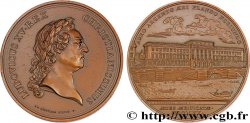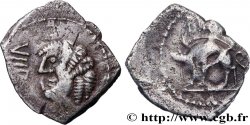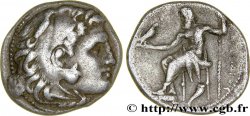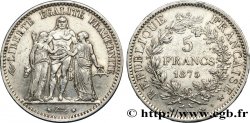Live auction - fjt_993644 - LOUIS XV DIT LE BIEN AIMÉ MARIE-THÉRÈSE D’ESPAGNE, DAUPHINE et MARIAGE DE LOUIS XV n.d.
Devi Sign-in ed essere un offerente approvato fare un'offerta, Login per fare offerte. Conti sono soggetti ad approvazione e di approvazione sono raggiunti entro 48 ore. Non aspettare fino al giorno di una vendita si chiude per registrarti.Confermando la tua offerta su questo oggetto ti impegni ad un contratto legalmente vincolante per l'acquisto di questo prodotto e fare clic su «offerta» costituisce accettazione dei termini di utilizzo de live auctions cgb.fr.
Offerta deve essere collocato in euro gli importi interi vendita only.The si chiuderà al momento sulla descrizione dell'oggetto, eventuali offerte pervenute al sito dopo l'orario di chiusura non verranno eseguite. Volte transmition possono variare e le offerte potrebbero essere respinto se si attende per gli ultimi secondi. Per ulteriori informazioni ckeck le FAQ Live auction.
Le offerte vincenti saranno sottomesse ai 18% per spese di compartecipazione alla vendita.
Le offerte vincenti saranno sottomesse ai 18% per spese di compartecipazione alla vendita.
| Valutazione : | 100 € |
| Prezzo : | 100 € |
| Offerta maxima : | 145 € |
| Data di fine vendita : | 11 febbraio 2025 16:58:14 |
| partecipanti : | 3 partecipanti |
Tipo : MARIE-THÉRÈSE D’ESPAGNE, DAUPHINE et MARIAGE DE LOUIS XV
Data: n.d.
Metallo : rame
Diametro : 29 mm
Asse di coniazione : 6 h.
Peso : 7,27 g.
Orlo : cannelée
Marchio : sans poinçon
Grado di rarità : R1
Slab

GENI : MS62
Commenti sullo stato di conservazione:
Taches d’oxydation. Petite usure. Aspect irisé
N° nelle opere di riferimento :
Diritto
Titolatura diritto : MARIA THERESIA DELPHINA.
Descrittivo diritto : Buste de Marie-Thérèse d’Espagne.
Rovescio
Titolatura rovescio : (FLEUR) LUD XV D. G. FR ET NAV REX MARIA STANIS. REG. FIL..
Commento
Marie Thérèse Raphaëlle d’Espagne, infante d’Espagne et dauphine de France, née le 11 juin 1726 à l’alcazar royal de Madrid (Espagne) et décédée le 22 juillet 1746 au palais de Versailles (France), est un princesse espagnole, fille de Philippe V, roi d’Espagne et d’Élisabeth Farnèse.
Son mariage avec le dauphin Louis-Ferdinand de France marquait la réconciliation entre la France et l’Espagne, parallèlement à celui de Madame Première avec l'infant Philippe après l'échec des fiançailles de Louis XV et de Marie-Anne-Victoire, sœur aînée de Marie-Thérèse et Philippe.
Le mariage eut lieu le 23 février 1745. C'est au cours des festivités du mariage que le roi pris comme maîtresse madame d'Etiolles (qu'il fit bientôt marquise de Pompadour).
Très timide, distante, la dauphine préférait la plupart du temps demeurer dans ses appartements et détestait le jeu.
Le mariage ne fut pas consommé dans ses premiers temps, ce qui gêna la dauphine vis-à-vis de son époux et de la cour qui faisait courir le bruit que le dauphin, âgé de 16 ans, était impuissant. l'union ne fut consommée que 7 mois après les noces en septembre 1745. Cet événement rapprocha les époux, qui passèrent dès lors la plupart du temps ensemble, dans une grande dévotion, à l’opposé du roi qui vivait séparé de la reine depuis près de 10 ans, ne pouvait plus communier depuis des années, mais fréquentait surtout les appartements de sa nouvelle favorite.
Peu après, Marie-Thérèse se trouva enceinte. L’accouchement était prévu pour le début juillet 1746, mais le terme se fit attendre, ce qui exaspérait la patience de Louis XV, des diplomates, de la cour et du peuple.
Finalement, princesse mit au monde, le 19 juillet 1746, une petite fille que le dauphin, profondément épris, fit immédiatement prénommer Marie-Thérèse pour rendre hommage à son épouse adorée.
La dauphine ne se remit pas de son accouchement et mourut le 22 juillet, c'est-à-dire trois jours plus tard.
Pour le reste de sa biographie lire http://fr.wikipedia.org/wiki/Marie_Th%C3%A9r%C3%A8se_d%27Espagne .
Maria Theresa Raphaëlle of Spain, Infanta of Spain and Dauphine of France, born June 11, 1726 at the Royal Alcazar of Madrid (Spain) and died July 22, 1746 at the Palace of Versailles (France), is a Spanish princess, daughter of Philip V, King of Spain and Elizabeth Farnese.
Her marriage to the Dauphin Louis-Ferdinand of France marked the reconciliation between France and Spain, alongside that of Madame Première with the Infante Philippe after the failure of the engagement of Louis XV and Marie-Anne-Victoire, elder sister of Marie-Thérèse and Philippe..
The marriage took place on February 23, 1745. It was during the wedding festivities that the king took Madame d'Etiolles (whom he soon made Marquise de Pompadour) as his mistress..
Very shy and distant, the dauphine preferred to stay in her apartments most of the time and hated gambling..
The marriage was not consummated in its early stages, which embarrassed the Dauphine in the eyes of her husband and the court, which spread the rumor that the Dauphin, aged 16, was impotent.. the union was not consummated until 7 months after the wedding in September 1745. This event brought the couple closer together, who from then on spent most of their time together in great devotion, unlike the king who had lived apart from the queen for almost 10 years, had not been able to receive communion for years, but mainly frequented the apartments of his new favorite..
Soon after, Maria Theresa found herself pregnant.. The birth was scheduled for the beginning of July 1746, but the due date was delayed, which exasperated the patience of Louis XV, the diplomats, the court and the people..
Finally, on July 19, 1746, the princess gave birth to a little girl whom the dauphin, deeply in love with, immediately named Marie-Thérèse to pay homage to his adored wife..
The dauphine did not recover from childbirth and died on July 22, three days later..
For the rest of his biography read http://fr. Wikipedia. org/wiki/Marie_Th%C3%A9r%C3%A8se_d%27Spain
Son mariage avec le dauphin Louis-Ferdinand de France marquait la réconciliation entre la France et l’Espagne, parallèlement à celui de Madame Première avec l'infant Philippe après l'échec des fiançailles de Louis XV et de Marie-Anne-Victoire, sœur aînée de Marie-Thérèse et Philippe.
Le mariage eut lieu le 23 février 1745. C'est au cours des festivités du mariage que le roi pris comme maîtresse madame d'Etiolles (qu'il fit bientôt marquise de Pompadour).
Très timide, distante, la dauphine préférait la plupart du temps demeurer dans ses appartements et détestait le jeu.
Le mariage ne fut pas consommé dans ses premiers temps, ce qui gêna la dauphine vis-à-vis de son époux et de la cour qui faisait courir le bruit que le dauphin, âgé de 16 ans, était impuissant. l'union ne fut consommée que 7 mois après les noces en septembre 1745. Cet événement rapprocha les époux, qui passèrent dès lors la plupart du temps ensemble, dans une grande dévotion, à l’opposé du roi qui vivait séparé de la reine depuis près de 10 ans, ne pouvait plus communier depuis des années, mais fréquentait surtout les appartements de sa nouvelle favorite.
Peu après, Marie-Thérèse se trouva enceinte. L’accouchement était prévu pour le début juillet 1746, mais le terme se fit attendre, ce qui exaspérait la patience de Louis XV, des diplomates, de la cour et du peuple.
Finalement, princesse mit au monde, le 19 juillet 1746, une petite fille que le dauphin, profondément épris, fit immédiatement prénommer Marie-Thérèse pour rendre hommage à son épouse adorée.
La dauphine ne se remit pas de son accouchement et mourut le 22 juillet, c'est-à-dire trois jours plus tard.
Pour le reste de sa biographie lire http://fr.wikipedia.org/wiki/Marie_Th%C3%A9r%C3%A8se_d%27Espagne .
Maria Theresa Raphaëlle of Spain, Infanta of Spain and Dauphine of France, born June 11, 1726 at the Royal Alcazar of Madrid (Spain) and died July 22, 1746 at the Palace of Versailles (France), is a Spanish princess, daughter of Philip V, King of Spain and Elizabeth Farnese.
Her marriage to the Dauphin Louis-Ferdinand of France marked the reconciliation between France and Spain, alongside that of Madame Première with the Infante Philippe after the failure of the engagement of Louis XV and Marie-Anne-Victoire, elder sister of Marie-Thérèse and Philippe..
The marriage took place on February 23, 1745. It was during the wedding festivities that the king took Madame d'Etiolles (whom he soon made Marquise de Pompadour) as his mistress..
Very shy and distant, the dauphine preferred to stay in her apartments most of the time and hated gambling..
The marriage was not consummated in its early stages, which embarrassed the Dauphine in the eyes of her husband and the court, which spread the rumor that the Dauphin, aged 16, was impotent.. the union was not consummated until 7 months after the wedding in September 1745. This event brought the couple closer together, who from then on spent most of their time together in great devotion, unlike the king who had lived apart from the queen for almost 10 years, had not been able to receive communion for years, but mainly frequented the apartments of his new favorite..
Soon after, Maria Theresa found herself pregnant.. The birth was scheduled for the beginning of July 1746, but the due date was delayed, which exasperated the patience of Louis XV, the diplomats, the court and the people..
Finally, on July 19, 1746, the princess gave birth to a little girl whom the dauphin, deeply in love with, immediately named Marie-Thérèse to pay homage to his adored wife..
The dauphine did not recover from childbirth and died on July 22, three days later..
For the rest of his biography read http://fr. Wikipedia. org/wiki/Marie_Th%C3%A9r%C3%A8se_d%27Spain








 Segnalare un errore
Segnalare un errore Stampate la pagina
Stampate la pagina Condividi mia selezione
Condividi mia selezione Fai una domanda
Fai una domanda Consegnare / vendere
Consegnare / vendere
 Descrittivo
Descrittivo















